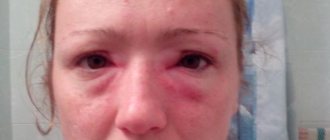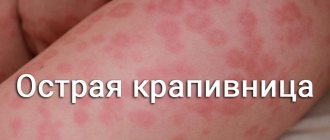Urticaria is a very common allergic skin disease. The disease received this name because the rash is very similar to the rash that appears on the skin after contact with nettles. The rash disappears quite quickly after contact with nettles, but what to do if the urticaria does not go away at all and no medications help, can we say that all means of combating it are useless?
Causes of urticaria
Urticaria can be caused by both internal and external causes. Studies show that women are twice as likely to suffer from urticaria than men. Considering this fact, doctors suggest that this disease may begin as a result of hormonal imbalance. Hormonal imbalance can be caused by changes in the menstrual cycle, taking birth control pills, pregnancy, and menopause.
At the same time, urticaria is not a fully understood disease, since often the reasons for its appearance remain unclear. This disease is called idiopathic urticaria.
Experts identify several causes of chronic urticaria:
- Changes in the immune system;
- Presence of infectious diseases;
- Diabetes;
- Food;
- Diseases of the gastrointestinal tract;
- Herpes;
- Gastritis;
- Leukemia
- Constant contact with the allergen.
In addition to the above, there are a large number of factors that cause the manifestation of urticaria.
Anamnesis
In addition to the duration of this episode, the presence of possible stimuli for its exacerbation is determined. During the interview with the patient, the doctor finds out:
- the cyclical appearance of elements and the duration of their “life”;
- presence of itching;
- description of possible stimulants of the phenomenon - stress, taking drugs, illness, etc.;
- a history of allergic diseases;
- the presence of traces after the disappearance of blisters - pigmented, flaky spots, vascular patterns;
- effectiveness of antihistamines;
- family history of urticaria.
Sometimes urticaria is only a single episode in a person’s life.
Types of urticaria
Urticaria comes in several types. It can be divided depending on the severity of the disease, the type of allergen that provoked its appearance or concomitant diseases. In medicine, the following types of this disease are distinguished:
- Acute urticaria. This type of disease is characterized by sudden development. A few minutes ago, a healthy person begins to notice the appearance of strange, itchy rashes on the body. If a person has encountered this disease for the first time, he does not understand what to do to neutralize the disease;
- Artificial urticaria. This course of the disease is atypical, since the patient practically does not complain of itching, and the rash has a linear shape. Typically, this disease manifests itself after mechanical irritation of the skin and quickly disappears;
- Chronic recurrent urticaria occurs when the patient is highly sensitive to irritants. Also, the occurrence of this disease can be triggered by the presence of infectious diseases and improper functioning of the gastrointestinal tract. The chronic course is characterized by constantly alternating phases of remission and exacerbation, depending on seasonality and the presence of allergens;
- Giant urticaria is characterized by rapid and severe swelling of not only the skin, but also the subcutaneous tissues. The face and lips are subject to swelling, and swelling of the genitals is possible. This type of urticaria is very dangerous and requires immediate hospitalization.
Treatment
It is difficult to treat urticaria in adults and children if the root cause of the rash is not found. Therapy must be aimed at eliminating the provoking factor, but it is not always possible to identify it.
If the root cause of urticaria in a child or adult has not been determined, the treatment regimen includes medications that support and strengthen the patient’s immunity and suppress the symptoms of the disease.
Means for local therapy
External preparations are used to relieve itching, pain, and swelling. Local medications help stop the spread of the rash throughout the body and prevent secondary infections from occurring.
Patients are prescribed the following medications:
- Fenistil-gel. The ointment disinfects the skin, relieves itching, pain, and restores epithelial cells.
- Hydrocortisone is a topical corticosteroid used for severe urticaria.
- Cream Gistan. Eliminates signs of an allergic reaction to epithelium: redness, itching, burning, dryness.
- Skin-Cap cream is a preparation containing zinc. Prevents the development of secondary infections: kills fungi, bacteria and other pathogens.
Injections
To suppress an allergic reaction, a child or adult is given intramuscular Prednisolone, a hormonal drug with an anti-shock, immunosuppressive effect. Prednisolone injections relieve inflammation and allergic reactions.
Preparations for internal use
For treatment, patients are prescribed:
- Antihistamines: Suprastin, Diazolin, Cetrin, Tavegil, Zyrtec, Erius.
- Medicines containing calcium. Medicines increase the tone of the vascular walls.
- Sorbents: Smecta, Enterosgel. Relieves intoxication, cleanses the body of allergens and poisons.
Diagnosing urticaria
Typically, diagnosing urticaria is not particularly difficult. The correct diagnosis can be made by a clinic doctor or an allergist-immunologist.
But there are cases when the patient is tormented by urticaria, and conventional medications do not help. Then a more in-depth examination is required. For this purpose, blood, urine and liver tests are taken. The doctor collects a general medical history. It is possible to prescribe a testing analysis to identify the irritating allergen.
Diagnosing urticaria is complicated due to the huge number of possible allergens, as these can be environmental factors such as cold or heat, food, household chemicals, and various diseases.
Laboratory and instrumental studies
Laboratory tests are not used for isolated episodes of acute urticaria.
Recommended laboratory and instrumental research methods:
- blood tests - clinical, biochemical;
- general urine analysis;
- colonoscopy;
- bicycle ergometry;
- radiograph of PPN and OGK;
- Ultrasound - according to indications;
- ECG and EGDS;
- parasitological examination;
- bacteriological cultures from the pharyngeal mucosa for flora;
- bacteriological studies of feces and duodenal contents;
- X-ray examinations of the paranasal sinuses and thoracic organs.
Diagnosis of physical types of urticaria is carried out using provocative tests - hot baths, water compresses, mechanical irritation of the skin, bicycle ergometry, etc. Tests with autologous serum are also used to identify the causes of urticaria.
Based on the results of research, a dermatologist may recommend consultations with other specialists:
- allergist,
- rheumatologist,
- oncologist,
- endocrinologist,
- parasitologist,
- gynecologist, etc.
Specialists together determine treatment regimens and methods.
Why does my skin itch?
The key mediator (conductor) of the reaction when this disease occurs is a substance called histamine. It plays a leading role in the pathogenesis (mechanism of development) of disorders; it causes symptoms such as:
- Blisters (urticaria) – do not have a cavity, are formed when the papillary layer of the dermis swells;
- Skin redness (hyperemia) and swelling as a result of increased vascular permeability;
- Itching of the areas where the rash is located.
Additional events
Treatment of urticaria requires, in addition to taking medications, following several rules. How to get rid of itching? Necessary:
- Wear loose clothing made from natural fabrics.
- Avoid intense rubbing of the skin, avoid using hard washcloths and products with scrubbing particles.
- Reduce showering (up to 15 minutes), give preference to warm rather than hot water. For aquagenic urticaria, that is, urticaria provoked by moisture, avoid swimming for a while.
- Limit physical activity.
- Avoid stress and anxiety.
- Do not eat hot or cold foods, drinks, alcohol, or spicy seasonings.
Of course, recommendations regarding a hypoallergenic diet and stopping contact with symptom provocateurs are relevant.
source
List of drugs
Since histamine is the main pathogenetic provocateur of urticaria, drugs that can influence the receptors with which it interacts are used to eliminate disorders. Their blockade allows you to prevent and/or stop all adverse effects provoked by the mediator. This group of drugs is called antihistamines. Let's look at how to relieve itching due to hives, in order.
Systemic antihistamines with sedative effect

These are 1st generation drugs, the so-called “old” forms. They affect the entire body as a whole and, in particular, the nervous system: they can provoke drowsiness, decreased concentration, dry mucous membranes, and urinary retention. Some options also have an antiemetic effect and suppress cough.
Chloropyramine (Suprastin)
Used as a drug for planned and emergency treatment of urticaria. It has a pronounced antihistamine effect and is widely used to relieve (stop) itching and swelling. It also has a moderate antispasmodic effect.
Suprastin is characterized by:
- rapid onset of effect;
- short period of action (up to 6 hours);
- incompatibility with ethanol.
It is allowed in childhood, but modern pediatricians often do not recommend using it for planned course therapy, so Suprastin is administered to a child, as a rule, only to relieve acute reactions. Adults require caution due to sedative effects.
Diphenhydramine ("Diphenhydramine")
One of the most famous antihistamines; in some cases it is used as a sleeping pill. It also acts as a local anesthetic (painkiller) - and in case of intolerance to the classical representatives of this group (Lidocaine, Novocaine) it can be considered as an alternative. Of course, this is useful for relieving itching. But there is a risk of skin necrosis at the site of contact, so the external use of Diphenhydramine is limited.
Ingestion also requires caution. Having stopped itching, the patient experiences difficulty remembering new material and concentrating. In addition, frequent uncontrolled use causes addiction. Diphenhydramine should not be taken with ethanol, as the inhibitory effect on the nervous system increases. Currently, the drug is used only for emergency care during the acute period of urticaria; it is not recommended for routine use in adults and children.
Clemastine (Tavegil)
Another well-known drug, which is available in the form of tablets and injection solutions. Used to provide emergency care - for urticaria, it quickly and effectively eliminates swelling and itching. However, it is known as a potential provocateur of allergic reactions, which, although it sounds contradictory due to its direct purpose as an antihistamine, may still be true. For this reason, caution is required in patients with drug sensitivity.
It lasts quite a long time - on average, from 12 to 24 hours. The effect of depression of the nervous system is present; the drug is approved for children from 6 years of age, although in case of an emergency it can be used in patients younger than this age (but older than 1 year). Adults can use it without restrictions (if there are no contraindications), but during pregnancy and lactation it is not recommended.
Cyproheptadine (Peritol)
As an antipruritic agent it is quite effective; is the drug of choice for cold urticaria. Has such effects as:
- Appetite stimulation.
- Anti-anxiety, antidepressant effect.
- Potentiating (increasing) the effect of other sedatives.
"Peritol", despite its effectiveness, is not recommended for elderly people, children, pregnant and lactating women. The drug is incompatible with alcohol. It is also not prescribed to patients whose quality of work depends on concentration (drivers, technicians, engineers, etc.). It lasts for about 6 hours, which requires regular use to prolong the effect and increases the risk of overdose.
If necessary, sedative antihistamines should be taken in the evening.
Since the period of action of the medicine is limited (about 6 hours), the patient will not experience drowsiness or decreased concentration after waking up.
Systemic antihistamines without sedation
2nd and 3rd generation drugs, “new” forms. They do not have a hypnotic effect, although in some people they can still cause short-term, mild drowsiness.











